

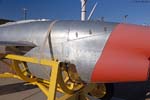
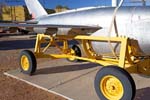
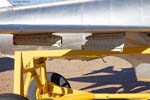



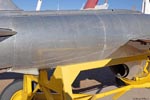
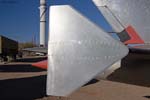
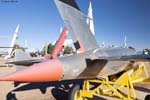
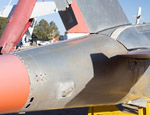
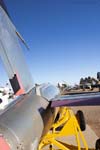

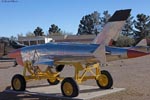
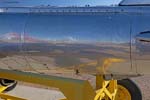

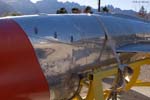
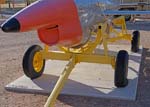

In December 2023, Bryan Wilburn visited the 'Missile Park' at the White Sands Missile Range Museum. He identified a new Firebee as a unique example: the Model 336 HATS used for laser tests. Bryan supplied the following comments with his photo report:
The Model 336 'High Altitude Target Skylite' (HATS) started out as a Navy BQM-34S. It flew with two sensor disks under the wings. 'Firebees and other UAVs' indicates the disks were 53" across with 300 sensors on each disk. The sensors were encased in 2 1/2" thick units, covered in gold coated aluminium. The book also mentions 31" diameter discs, and indicates that several target aircraft were in a flight ready status at the time the book was published in 1992. The only flight documented in the book was on July 23, 1990 where the vehicle reached 50,000 feet.
Bryan made the following notes to go with the photos (numbering goes left to right, top to bottom):
photo 5: 'Firebees and other UAVs' page 140 shows the pylons covered with skins, that are absent on this Firebee
photo 6: wingtip end plates / skids, not seen on other Firebees. It looks like they protrude lower than the laser receiver disks to protect them in landing
photo 12: aft attachment point for the JATO unit for ground launch. The supports for the JATO is slipped in, they are not secured. When the rocket is jettisoned the unit rotates downward about the rear attachment points, slips out and falls away
photo 17: wire bundles for the laser receivers
photo 19: the flight bird had a clear nose cap, probably with a laser receiver.
the trailer appears to be non standard as I have not seen it used with Firebees before
Some more notes:
photo 1: the inlet face coincides with the rear of the radome, strongly suggesting it has the J69 engine
photo 7: the exhaust matches that of the J69 engine; you can see the outer heat shield and the actual exhaust inside the heat shield
photo 11: the remains of two stickers can be seen, presumably of the HATS project
no identity is visible
the Firebee still shows its highly polished skin

|

|

|

|

|

|

|

|

|

|

|

|

|

|

|

|

|

|

|

|
I was puzzled by the two disc diameters mentioned in 'Firebees and other UAVs'. A simple sketch with both discs showed that the 53" disc matched the top photo in the book (page 141), although the caption says they are 31". But the smaller photo at the bottom of the same page seems to show a much smaller disc, half hidden in the brush of the landing spot. Likely both disc sizes were used. Another puzzle is that the large photo in the book (page 141) shows the 53" disc, but the sensor area is roughly 42" in diameter, not 31" as mentioned in the text.

|